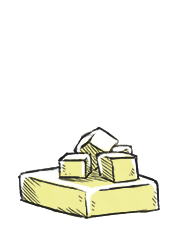burmese tofu

Burmese tofu is not made from soybeans, but with besan (chickpea) flour. It's made in a way that is similar to polenta, by mixing flour with water, turmeric and salt. Burmese tofu is yellow, with a jelly texture that doesn't crumbled when cut or sliced. Burmese tofu can be fried, eaten in salads, curried etc. It is also used as an alternative to tofu for individuals who are sensitive to soy products.
chickpeas
Chickpeas are the earliest cultivated legumes in history, and a staple in many countries. They are very rich in protein, and a good source of iron.
Chickpeas can be made into flour, they can be roasted, pureed, candied etc. It's a very versatile and inexpensive legume. The cooking liquid of chickpeas — aquafaba — can be used as an egg replacer in recipes.
Dry chickpeas keep a long, long time. If you keep them in air-tight containers they will last even longer, because moisture and oxygen is the enemy of all beans. Oxygen makes the bean oils rancid overtime. You can store them for 5+ yrs if you add oxygen absorbers (packet consisting of powdered iron oxide) to the containers.
How to cook dried chickpeas
Dried chickpeas triple in size when cooked (if not a little more). So 170 g (1 cup) of dried chickpeas will make about 510 g (3 cups) of cooked chickpeas. Dried chickpeas have a tough outer skin, and should be soaked overnight. Soaking them cuts down on cooking time, and in turn, saves energy. It also helps the beans cook more evenly and become tender all the way through. Another advantage to presoaking beans is that most of the gas-causing sugars are leeched out into the soaking water. So when you drain off the soaking water, you are also getting rid of this unpleasant side effect to eating beans. Next morning, drain and cook them in a pot or pressure cooker.
Stove top Pot: Bring chickpeas to a boil, then lower to gentle simmer. Add salt when beans are almost cooked. In a pot, cooking them varies from 1-3 hours.
Pressure cooker: Because beans cook differently depending on the kind, age, and whether or not they’ve been presoaked, quick-soaked or not soaked at all, there is no single all-encompasssing rule for pressure cooking beans. Having a good chart with all the variables to consult is important so that you can adjust to your circumstances. A good resource for this is Hip Pressure Cooking’s bean chart. It’s a good idea to add 1 tbsp of neutral oil to the pot. Beans produce foam when cooking which can clog the pressure valve, and the oil will help to keep that down.
